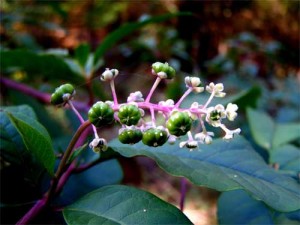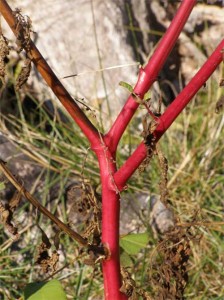My favorite plant, poke
By Ken Moore
I was amused at Andy Borowitz’s description of Labor Day week “pointless Filler columns.†Tell-tale signs of columnists taking an out-of-town break, he describes, are rehashing older columns, using lengthy quotes and repeating themselves throughout the column.
I can’t imagine that serious writers would actually stoop to those tactics.
As I anticipate doing a little salt-water fishing, really going east to take that closer look at coastal plants, I am taking the time to describe my favorite plant, pokeweed!
“My poke’s bigger than your poke!â€
That brag has passed between more than two energetic gardeners in this area. While most folks consider the common American pokeberry, or poke salad, Phytolacca americana, a weed, really sophisticated gardeners admire and grow this giant native perennial.
Poke is a striking plant for all seasons. It flowers and fruits into the late fall, and it’s difficult for me describe my favorite aspect of the plant. It’s probably the stem; no other image stops me in my tracks more than the stark beauty of poke’s brilliant red stems in late summer and early fall!
The tiny pendulous flowers bloom throughout the growing season. A “closer look†reveals white petals surrounding emerald-green centers, contrasting with pink-to-burgundy-colored stems. I am always stopped in my stride, unbelieving such color schemes. Though I am known to sing the praises of any native plant presently in my view, no other wild plant evokes my exuberance more than the common poke!
I love everything about this plant. The flowers have little emerald-green centers that mature into berries turning from green to pink and finally shiny black. Daily entertainment is provided by our year-long resident mockingbird competing furiously with the summer resident catbird for the ripe berries.
From late summer through the entire fall, the 4-to-8 foot-tall branching stems of the poke are a brilliant scarlet to rhubarb burgundy-red. When highlighted by low-angle morning and evening sunlight, there is no more spectacular effect in the wild or managed landscape.
Even in the dormant months, the dried tan-colored stems of poke remain an interesting architectural feature. I never cut stems down until the emergence of the lush green leaves from the base of the plant in the early spring. Then we refer to this special plant as poke salad.
If you have never enjoyed eating poke salad, then you are missing out. Visit the farmers’ market in early spring to get cooking strategies from some of the old-timers there. Make certain you note the details, because poke is also a poisonous plant, so you have to know what you are doing to safely enjoy this culinary treat.

Pokeweed’s white petals surround a little green pumpkin-like fruit, attached to a ruby-pink stem, is unbelievably beautiful. Photo by Ken Moore.
Poke has everything. In addition to the sheer beauty of the plant, it is edible, it is poisonous and it is medicinal. Wish I had the space to relate my annual conversation with a friend who collects the dried berries by the pint jar and delivers them to her 90-year-old aunt, who concocts a special tea to relieve the pains of arthritis and rheumatism. Don’t you try it until you know what you are doing!
Poke stories abound. Some notable ones, recorded by local legend Paul Green, are found in Paul Green’s Plant Book. Check out the wild story about poke as a poison ivy cure. I suspect you won’t try the cure, but you will never forget the tale.



Comments are closed.